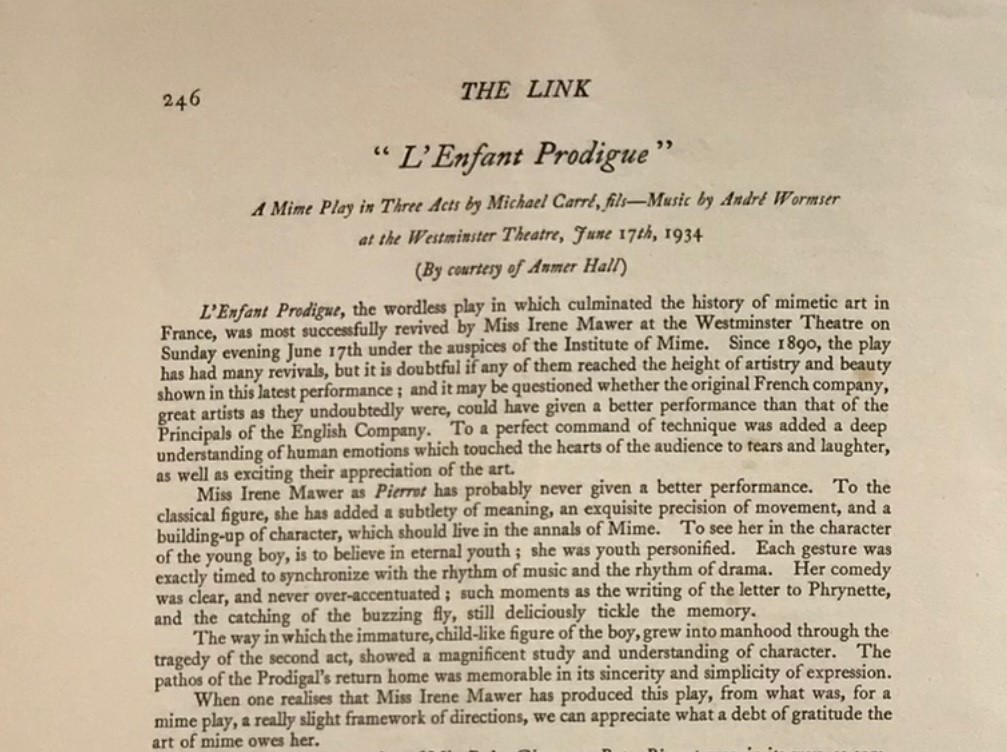Let’s Not Pretend – Mawer’s Technique
For some time, I have been struggling with how to tell you what Miss Mawer’s mime technique was like. I have been looking for ways to describe it in words. I still haven’t found my answer, but I think the following critical review of one of her performances might go some way to helping give a picture of her style.
When Miss Mawer played Pierrot, the miming would have been completely natural. I don’t mean ‘natural’ in any special manner, I mean that she would have portrayed a person in a totally natural way – not stylised. From photographs that I have seen, I know that she would have been in costume, with white face make-up. Also, the set would have been fully dressed, with furniture and props (including hand props).
When I learned mime, I didn’t have any hand props. If I was portraying a character who was doing something, then I would mime the item that I was holding. So, if I was filling a bucket of water from a tap, I would mime holding the bucket and I would mime turning the tap on and off. I would move my hands and my body in the exact way that my character would have moved. If I was drinking tea, perhaps adding a spoonful of sugar and stirring it in, I would have to make sure that I left a tiny gap of the correct width when I was holding either the spoon or the handle of the cup. I would be required to lift up the cup and set it down in exactly the same place (if I was setting it onto a saucer). If I took more than one spoonful of sugar, then I would have to be sure to put the spoon into exactly the same place (ie, the sugar bowl) both times.
The following passage, which discusses teaching mime to children, clearly explains this aspect of Irene Mawer’s technique: “Training begins with mimetic handling of objects which the children use every day – balls, beads, mugs, plates and such things. When they can see and feel the shape of these, they may use them in occupations and gradually work to the visualization of things which are out of reach or rarely seen, and to actions which necessitate the visualization of several objects.” (Susan Pearson, The Link, April 1938, p.15) From my own training, I can say that Irene Mawer felt it was important that the students ‘imagine’ something, as opposed to ‘let’s pretend’ – that approach makes a huge difference.
When Ginner-Mawer dancers danced, they often used hand-held props, such as spears or urns in the Greek dances. Equally, they could dance without the props, and mime them. This, I think, is the key to the mime – I am guessing that if props were there, then they would be used, equally, if one was performing but not in costume, then the objects would be mimed. In my own mime training, I don’t recall ever using any props, other than sometimes dancing with a scarf. And certainly, when Miss Mawer taught educational classes, such as the ones in Holloway Prison, or at the Women’s Institute, the students would not have used props – it wouldn’t have been feasible. So they would have mimed everything.
Here, then, is how Helga Burgess described Miss Mawer’s performance in 1934 (The Link, July 1934, p.246). She starts by telling us that L’Enfant Prodigue is a wordless play, which has had major success during several revivals since 1890. While noting that the French actors were amazing, she felt that Irene Mawer equalled, if not surpassed, them: “To a perfect command of technique was added a deep understanding of human emotions which touched the hearts of the audience to tears and laughter.”
The reviewer then explains how Miss Mawer was very precise in her movements (which fits in with my training) and that she built up character (again, this was a large part of the training): “To the classical figure (of Pierrot), Miss Irene Mawer has added a subtlety of meaning, an exquisite precision of movement, and a building-up of character.”
Mawer portrayed Pierrot as changing from boyhood into manhood: “To see her in the character of the young boy…she was youth personified…The way in which the immature, child-like figure of the boy grew into manhood…showed a magnificent study and understanding of character. The pathos of the Prodigal’s return home was memorable in its sincerity and simplicity of expression.” Again, that, I think, is a true depiction of what Mawer’s technique was all about – no over-acting, no hamming it up, just plain, simple expression of feeling combined with correct technique.

